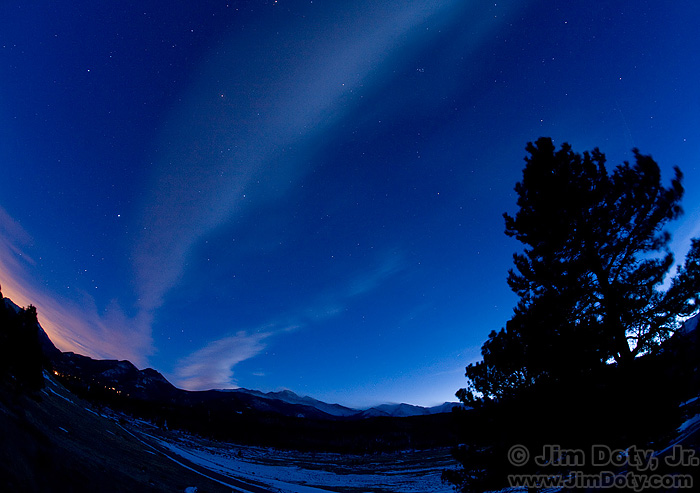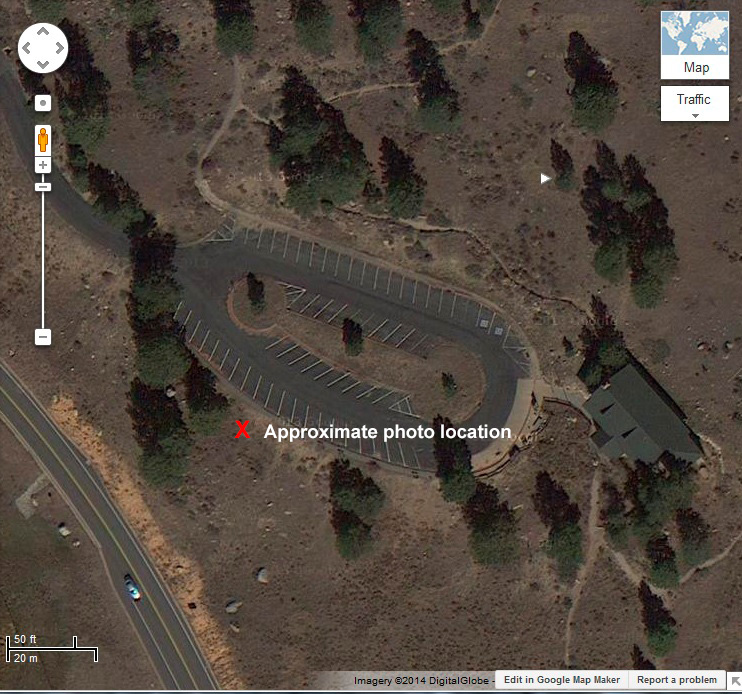Rocky Mountain National Park can be beautiful any time of year, including late February when I created this image. It’s not too late to catch the splendor of a RMNP winter, and February is a good month to go.
For this image I was near the Visitors Center in Moraine Park and facing south. I’ve used the area in or near the trees at the west end of the parking lot a number of times. It is one of my favorite locations in RMNP to do twilight and night photography.
I was drawn to the clarity of the stars in the sky, the snow covered mountains, the sweeping curve of the clouds in the late evening light, and the pinkish-yellow clouds to the lower left which were catching the glow of distant city lights. It is a landscape photo at twilight. I positioned my camera so the trees at the right are a counterpoint to the clouds that begin to the lower left and curve up over the trees. Without the trees (which I could eliminate by simply moving a few feet to the left), I found the composition less interesting.
The only lens that would take in this much of the sweep of the clouds was a 15 mm semi-fisheye lens which has a diagonal field of view of 180 degrees. All fish-eye lenses bend straight lines near the edges of the frame so the horizon at the bottom of this photo is bowed due to the optics of the lens.
The sun set at 5:49 pm and this photo was taken at 6:43 pm (“nautical twilight” at this location was at 6:49 pm), so it was darker out than this photo would indicate. I used an exposure that was long enough to give me some blue in the sky. My camera was mounted on a tripod. An aperture of f/6.3 gave me plenty of depth of field for both the nearby trees and the distant stars. I picked an ISO of 400 to give me a shutter speed of 30 seconds. Any longer and the stars would “trail” too much due to the motion of the earth.
For those of you who are interested in the stars of the winter sky, ORION “The Hunter” is in the middle of the largest cloud. Sirius, the “Dog Star” and brightest star in the sky, is in CANIS MAJOR located between ORION and the “city lit” clouds at lower left. In the upper center is the small V shaped asterism know as “The Hyades” which forms the head of TAURUS “The Bull”. To the right, also in Taurus, are the Pleiades, the “Seven Sisters”. In Greek mythology they are siblings to the Hyades. ARIES is just above the tree tops and TRIANGULUM is above that. The bright stars at the upper right are part of ANDROMEDA.
Rocky Mountain National Park can be bone chillingly cold, or it can be surprisingly pleasant. Dress warm and carry a winter travel kit in your car (water, canned food that is high in protein, can opener, candles and matches in a metal can large enough to burn the candles in as a small heater, blanket or sleeping bag). On this trip it was pretty nice. Much of the time my coat wasn’t zipped, I didn’t have a cap on my head or the hood of the coat up, and I often wasn’t wearing gloves.
Photo Data: Canon 5D. Canon EF 15mm f/2.8 lens. 30.0 sec, f/6.3, ISO 400.
Links
For more information on night sky photography, exposure, depth of field, composition, and landscape photography, read Digital Photography Exposure for Dummies, one of the highest rated photography books at Amazon.com. You can learn more here and order it at Amazon.com.
Rocky Mountain National Park – the official NPS web site.
Civil, nautical, and astronomical twilight.
Lodging
My two favorite places to stay in Estes Park.
The owners of both are super nice. Colorado Cottages is right behind Alpine Trail Ridge Inn. They are close to the RMNP entrance on the far west side of Estes Park (so you don’t have to fight the crowds in town during the busy tourist season). Book well ahead during the busy season (summer through fall colors and the elk rut). Colorado Cottages is open all winter. Alpine Trail Ridge Inn is open from early May through early October.


